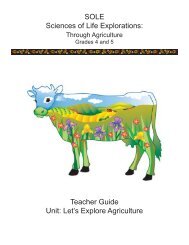Insect Anatomy - Agriculture in the Classroom
Insect Anatomy - Agriculture in the Classroom
Insect Anatomy - Agriculture in the Classroom
Create successful ePaper yourself
Turn your PDF publications into a flip-book with our unique Google optimized e-Paper software.
Teacher Information for Student Workseets<br />
Student Worksheet 1<br />
Don’t Bug Me!<br />
<strong>Insect</strong>s are all around us. Millions can exist <strong>in</strong> a s<strong>in</strong>gle acre of land. Many <strong>in</strong>sects are consumers and<br />
recyclers of plant and animal material. This helps our soil. <strong>Insect</strong>s are a major food source for o<strong>the</strong>r animals.<br />
When a mosquito is pester<strong>in</strong>g you or someth<strong>in</strong>g is eat<strong>in</strong>g <strong>the</strong> leaves of your favorite plant, your op<strong>in</strong>ion of<br />
<strong>in</strong>sects may be low. But <strong>the</strong>y are an important part of our world; highly valuable <strong>in</strong> <strong>the</strong> food cha<strong>in</strong>. Our<br />
environment would not exist as we know it without <strong>in</strong>sects!<br />
Student Worksheet 2<br />
What Do You Know About <strong>Insect</strong>s<br />
ts very common for people to use <strong>the</strong> term “bug” to describe <strong>in</strong>sects <strong>in</strong> general, plus o<strong>the</strong>r creatures that crawl<br />
or fly. The goal of <strong>the</strong>se activities is to teach what exactly an <strong>in</strong>sect is, and how varied and <strong>in</strong>terest<strong>in</strong>g <strong>in</strong>sects<br />
can be. It is <strong>the</strong> variety of ways <strong>in</strong>sects <strong>in</strong>teract <strong>in</strong> <strong>the</strong>ir environment that makes <strong>the</strong>m as successful as <strong>the</strong>y<br />
are. When we take <strong>the</strong> time to learn about someth<strong>in</strong>g, our fear lessens and our appreciation <strong>in</strong>creases.<br />
Student Worksheet 3<br />
What Is an <strong>Insect</strong><br />
Students will use this sheet to test <strong>the</strong>ir knowledge of <strong>in</strong>sects. Rem<strong>in</strong>d <strong>the</strong>m that <strong>in</strong>sects have three ma<strong>in</strong><br />
body regions (which are not always easy to detect) and three pairs of jo<strong>in</strong>ted legs. Rem<strong>in</strong>d students that<br />
different life stages will not seem to follow those rules. Caterpillars, for example, have a version of <strong>the</strong> three<br />
body regions rule, and <strong>the</strong>y do have three pair of true legs attached to <strong>the</strong> thorax. However, caterpillars<br />
have additional stubby limbs, which are not true, jo<strong>in</strong>ted legs.<br />
Answers:<br />
1. 6, 3<br />
2. Dragonfly, Fly, Grasshopper, Ant, Butterfly, Mosquito, Beetle, Pray<strong>in</strong>g Mantis, Caterpillar, Bee
















